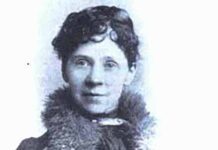In the late 1520s, if you wished to be ANYONE at the court of Henry VIII, you had to seek the favor of his mistress (although by all accounts he was not sleeping with her), Anne Boleyn. The actual queen, Catherine of Aragon, was persona non grata at court, although she retained the love and respect of the common people. Her influence with the king had waned to near nonexistence, and the cozy family trio of Henry, Catherine and the Princess Mary was a thing of the past. There was a new queen bee in the hive, around whom all courtiers – and the king – frantically buzzed: the bewitching, bewildering, enigmatic, witty and vivacious Anne Boleyn. Henry, faithful husband of over 20 years, was besotted by this magical lady, completely oblivious to the gossip, scandal and international outrage he was creating.
It was an odd threesome which now spearheaded court doings. Henry and Catherine still appeared together at official court functions, still spent holidays in apparent familial intimacy – but Henry had long since ceased to visit his wife’s bed, or even to spend much time with her outside of necessity. His romantic outlet was now confined to courtship of Mistress Anne, who occupied her own set of chambers in every palace, reveled in the attention of all who wished for advancement and received a king’s ransom in gifts from Henry (who eventually probably would have gladly given the same price to ransom himself from the international and ecclesiastical mess he created through his single-minded pursuit). Anne still nominally functioned as the queen’s lady-in-waiting, but it would have been an odd wife who could contemplate with equanimity the presence in her chambers of one who was ostensibly her servant but who was, in reality, the glowing and none-too-retiring object of her husband’s affections. As Henry made no secret of his preference at this point in time, Katherine must have felt humiliated and hurt in the extreme.
An anecdote comes down to us from this period which demonstrates palpably the tension which must have reigned in the halls of Henry’s palaces. We find Anne playing chess, of all things, with her mistress, the Queen. Catherine watches her opponent’s clever moves for a time, and then remarks quite pointedly, “Most would do well to stop at a pawn, Mistress Anne, but you will not stop but at a king. You must needs have all.” Needless to say, there are no other stories of interaction between Catherine and Anne.
After about 1530, Henry openly began to try to manipulate and cajole the Pope into granting his desired divorce. On the face of it, this should not have been such an outlandish request. There was plenty of precedent, and certainly the marriage was arguably valid at best. Katherine had previously been married to Henry’s older brother, Arthur, who had been destined for kingship. The marriage had ended with Catherine’s widowhood in 1501, and she had lived, unrecognized and uncourted, in the palaces of Henry VII, for eight years, a now-valueless pawn in the great game of international statesmanship. As a widow she was “damaged goods”, and although she could easily have been used in yet another marriage bargain, such as an alliance with France or one of the German Duchies, she remained in her anomalous position at the English court while her father, King Ferdinand of Spain, wrangled with King Henry over her dowry, which Henry claimed should be fully his, and which Ferdinand contested should be returned to him because the bargain had fallen through with the death of the groom. Henry VII finally agreed that Catherine should remain in England until the future Henry VIII, a bewildered 11-year-old at the time of his accession to the succession, should be old enough to wed her in his turn and thus save the alliance. But the young lad was made to sign a secret document protesting his betrothal on grounds that it constituted incest with his former sister-in-law, and that it was contrary to the laws of God and the Church. This document was kept secret, and hidden away to be produced in case of need.
Fortunately for Catherine, when Henry VIII advanced to his father’s throne in 1509, it developed that there was nothing he would like better than to marry the winsome, auburn-haired, petite Spanish princess. She was six years his senior, and he, a romantic young man of 19, may have seen himself as the knight who was to save her from the humiliating and impoverished position she occupied at court. They were married not long after his accession, but the questions as to the validity of the marriage would remain for years to come, and would eventually form the basis of Henry’s public objections to his marriage and his final break with the Roman Catholic Church.
Kings had for centuries applied to the Pope for annulments or divorces on much smaller grounds than Henry possessed. Not only was the validity of his marriage suspect, but the very future of England could be riding on the production of a male heir, which was very evidently a feat beyond Catherine at her age. The Wars of the Roses, which had resulted in a tenuous peace and unity in the British realm, were far too recent in memory to be discounted, and several scions of the house of Plantagenet remained at large to threaten the Tudor line, among them the Poles and the Howards, who had only recently been brought back into the fold from their “treasonous” support of Richard III. Henry’s own father had had to execute several pretenders to the throne, men who probably had a far better claim to occupy that seat, taking into account their lineage and blood lines.
Henry VIII’s own sister, Queen Margaret of Scotland, and his best friend Charles Brandon, the Duke of Suffolk, had both been granted repeated divorces on flimsier grounds than the future of a nation or the validity of a marriage contract. Furthermore, the Pope was fully aware of the threat to England – and any other Catholic nation – of the growing movement towards Protestantism in the schismatic person of Martin Luther and his heretical doctrines, not to mention the increasingly popular use of Tyndale’s English translation of the Bible, which finally allowed parishioners (those who could read) to decipher and interpret the word of God for themselves, instead of depending on the convenient wordings of the Church. It was paramount, therefore, to keep England in the Catholic fold, to appease her increasingly influential king (who, after all, had been named “Defender of the Faith” by the Pope for his refutation of Luther’s “95 Theses”), and to give the Protestant forces no further grist for their mill. Henry must have assumed, upon first applying to Pope Clement, that his divorce was as good as done – a simple stroke of the pen, and his way to marriage with his elusive sweetheart would be clear. He was to learn far, far otherwise.








